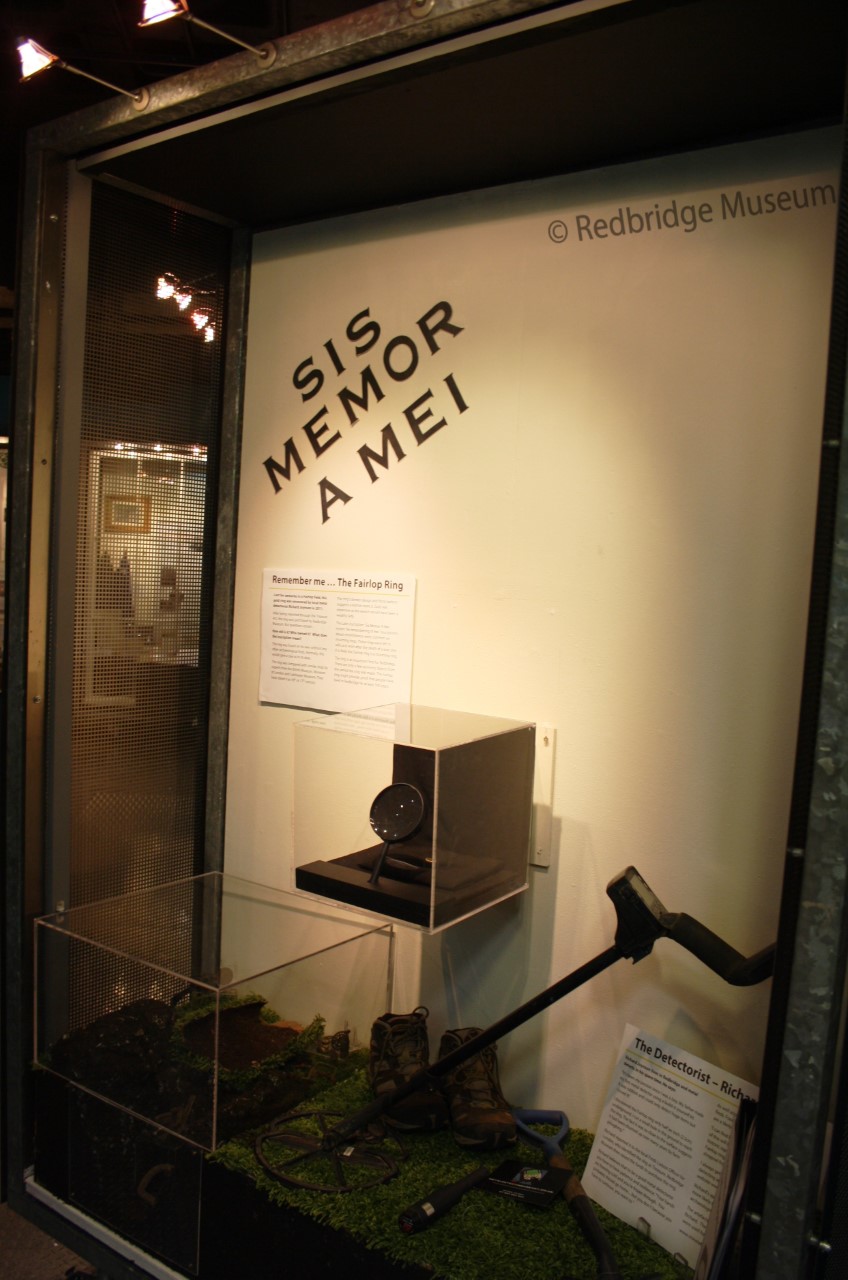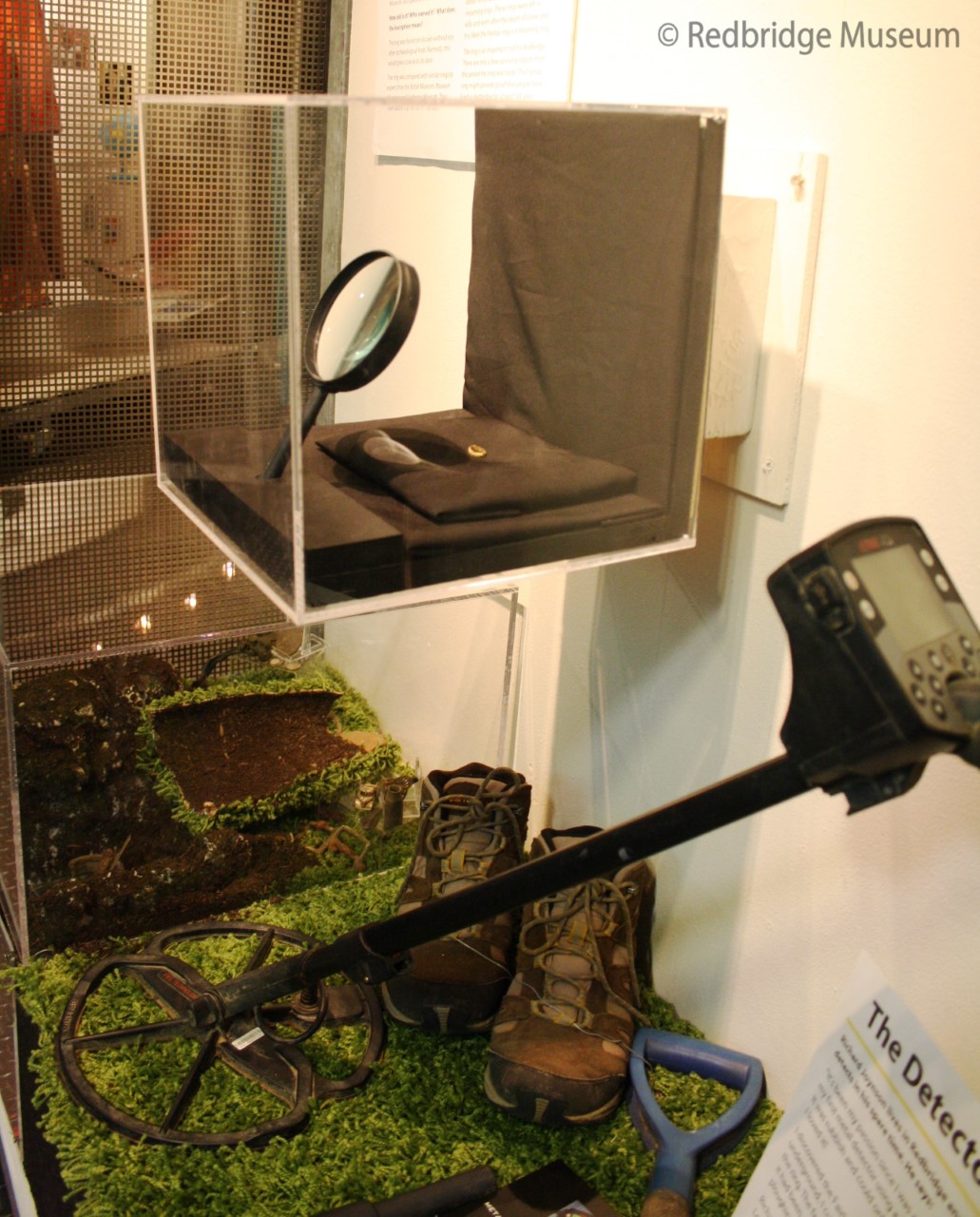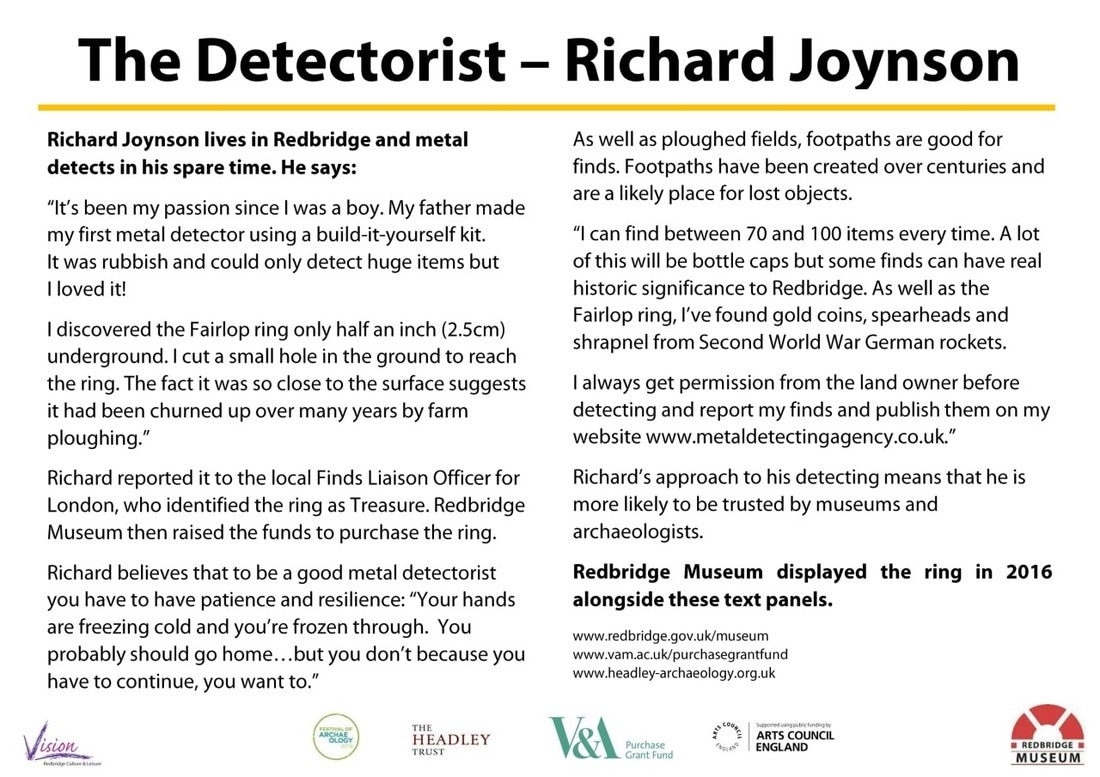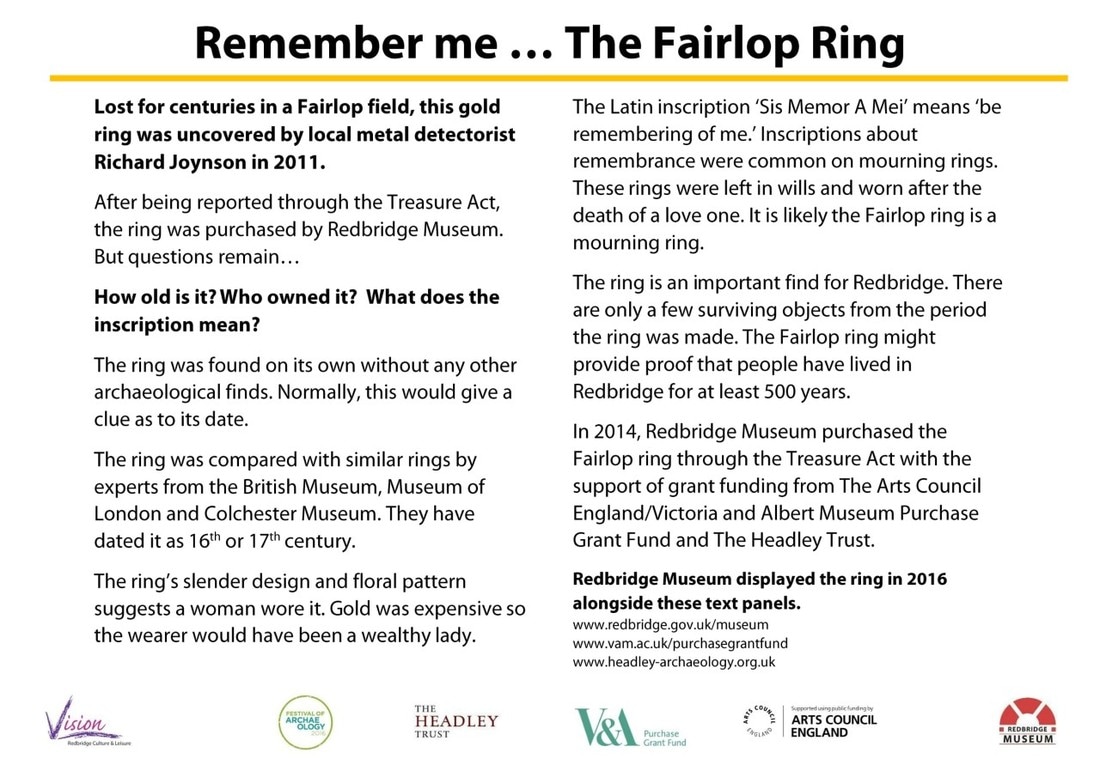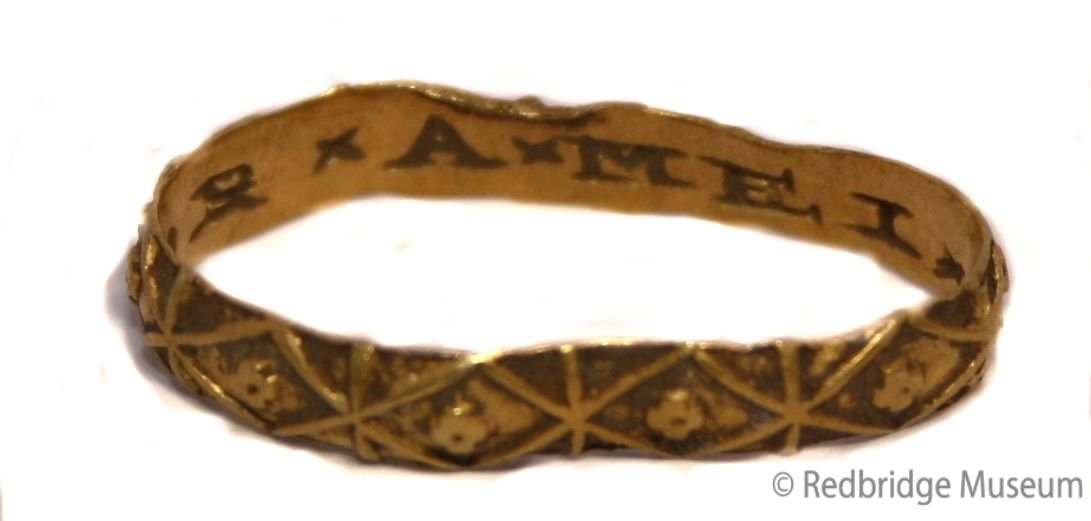
In 2014, Redbridge Museum purchased the Fairlop ring through the Treasure Act with the support of grant funding from The Arts Council England/Victoria and Albert Museum Purchase Grant Fund and The Headley Trust. Redbridge Museum displayed the ring in 2016 alongside these text panels.
Treasure: the hoard of silver coins found 6 years ago but took ages to go through the system. You can see them being found here
My amazing Roman fish/turtle Zoomorphic mount. Click here to see it being found live
Click here for museum images
MOUNT Unique ID: LON-B3AE96
Object type certainty: Certain
Workflow status: Awaiting validation
A probably Roman copper alloy mount dating AD43-410. The mount has been cast in the form of a fish or a dolphin with an elongated body which spirals around to form a ring. The tail flares out in a semi-circular shape and projects from the back of the ring. There is a rectangular socket projecting from the upper side edge of the ring. There are two fins which project each side of the head to form horizontal bars; the end of the one of the fins is broken and missing. The body of the fish is decorated with a scale-like pattern and there are flaring lines providing the detail on the tail. The fish has a broad, snub nose and the eyes are depicted by a ring and dot motif. On the underside of the head there is a circular, wedge-shaped lug or small stand which probably was in contact with another element.
Objects with similar depictions of fish or dolphins but slightly different forms are published on the Portable Antiquities Scheme database e.g. SWYOR-4D4182; LIN-5C2393 and LANCUM-F79885.
Ralph Jackson writes the style of the object is more Roman than Neoclassical and Hazel Forsyth added that she has not seen anything similar in the Post Medieval period. Jenny Hall suggests that it may have come from the side of a bowl and would have had some fitting attached through the rectangular slot, although she cannot find a parallel in the publications.
Dimensions: length: 58.43mm; width: 33.43mm; diameter: 27.93mm; weight: 39.08g.
Identification by Hazel Forsyth, Senior Post Medieval Curator, Museum of London.
Identifications by Ralph Jackson, Curator, Roman Collections, Department of Prehistory and Europe; The British Museum, Jenny Hall, Roman specialist and Hazel Forsyth, Senior Post Medieval Curator, Museum of London.
Subsequent actions Subsequent action after recording: Returned to finder
Chronology Broad period: ROMAN
Subperiod from: Early
Period from: ROMAN [scope notes | view all attributed records]
Subperiod to: Late
Period to: ROMAN [scope notes | view all attributed records]
Date from: Circa AD 43
Date to: Circa AD 410
Dimensions and weight Length: 58.43 mm
Width: 33.43 mm
Weight: 39.08 g
Diameter: 27.93 mm
Quantity: 1
Materials and construction Primary material: Copper alloy [scope notes | view all attributed records]
Manufacture method: Cast [scope notes | view all attributed records]
Decoration style: Zoomorphic [scope notes | view all attributed records]
Completeness: Incomplete [scope notes | view all attributed records]
Treasure Act number: 2013T144: 1600s gold button. Info not on Portable Antiquities Sceme website yet click here to see its finding live
Treasure Act number 2012T16: medieval, 12th Century, silver fede ring found Dec 2011 for photo click here
FINGER RING Unique ID: LON-121037
Object type certainty: Certain
Workflow status: Awaiting validation
A medieval finger-ring of stirrup shape with two clasped hands engraved on the back of the hoop. The hoop consists of a flat band with an inscription, which reads
+ A V E M(?) A R I A: G -
The last letter is incomplete but appears to form the vertical stroke for the letter 'R'. The full inscription would read:
A V E M A R I A G R A C IA P L E N A
(Hail Mary, full of grace)
This is the salutation of the Archangel Gabriel to the Virgin Mary at the time of the Annunciation of Christ's birth. The words carried amuletic significance in the Middle Ages, and were frequently inscribed on rings and brooches.
The finger-ring is silver and dates from the fourteenth century.
Dimensions: height 26 mm, width 24 mm.
Consequently, in terms of age and as the object contains a minimum of 10% precious metal it qualifies as Treasure under the stipulations of the Treasure Act 1996.
J P Robinson
Curator of Medieval Collections
24th February 2012
Subsequent actions Current location of find: Epping Forest Museum
Subsequent action after recording: Submitted for consideration as Treasure
Treasure detailsTreasure case tracking number: 2012T16
Chronology Broad period: MEDIEVAL
Subperiod from: Late
Period from: MEDIEVAL [scope notes | view all attributed records]
Subperiod to: Late
Period to: MEDIEVAL [scope notes | view all attributed records]
Date from: Circa AD 1300
Date to: Circa AD 1400
Dimensions and weight Height: 26 mm
Width: 24 mm
Quantity: 1
Treasure Act number 2011T668 post medieval silver thimble click here for images
THIMBLE Unique ID: LON-D91477
Object type certainty: Certain
Workflow status: Awaiting validation
A post medieval silver thimble or sewing ring. The thimble is made from a rolled sheet. Near the base edge of the thimble on the outer surface are stamped initials; 'MP', on a banner held up by a cherub on either side. Above the initials is a makers mark: '.JC.' within an oval with floral projections. Below the banner is a plain raised border. The rest of the thimble is covered in rows of circular indentations. The top of the thimble is open, and along one side of the thimble is the seam where the edges of the sheet meet. It is now slightly squashed and it measures 16.1mm (diameter at base) x 13.7mm (diameter at top) x 14.6mm (height) x 1.3mm (thickness) and weighs 4.50g.
Subsequent actions Current location of find: Epping Forest Museum
Subsequent action after recording: Acquired by museum after being declared Treasure
Treasure detailsTreasure case tracking number: 2011T668
Chronology Broad period: POST MEDIEVAL
Period from: POST MEDIEVAL [scope notes | view all attributed records]
Period to: POST MEDIEVAL [scope notes | view all attributed records]
Date from: Circa AD 1625
Date to: Circa AD 1725
Dimensions and weight Height: 14.6 mm
Thickness: 1.3 mm
Weight: 4.5 g
Diameter: 16.1 mm
Quantity: 1
Treasure Act number 2011T529 16-17th Century gold finger ring click here for image
FINGER RING Unique ID: ESS-745A21
Object type certainty: Certain
Workflow status: Awaiting validation
Treasure case: 2011 T529 Findspot: 'Redbridge Area', Greater London
Date: 16th - 17th Century
Description: Post-Medieval gold finger-ring, squashed. Exterior decorated... Inscription on inner band, retaining black enamel. Inscription reads: SIS MEMOR A MEI. The latin inscription translates literally to 'be remembering of me', ie. remember me (memora is female version, so this ring would have been given to a woman).
Dimensions: Diameter: 18.69mm (at widest point) Thickness: 0.60mm Band Width: 3.06mm Weight: 1.1g
Consequently, in terms of age and as the object contains a minimum of 10% precious metal it qualifies as Treasure under the stipulations of the Treasure Act 1996.
Disposition: To be determined
Report by: Judy Rudoe The British Museum
Subsequent actions Subsequent action after recording: Informed finder that the object should be submitted as Treasure. Update...now in Redbridge Museum
Chronology Broad period: POST MEDIEVAL
Period from: POST MEDIEVAL [scope notes | view all attributed records]
Date from: Circa AD 1500
Date to: Circa AD 1700
Dimensions and weight Weight: 1.1 g
Diameter: 18.96 mm
Quantity: 1
Discovery dates Date(s) of discovery: Sunday 1st May 2011 - Tuesday 31st May 2011
Treasure Act number 2010T644 1657 Protectorate gold ring click here for image
FINGER RING Unique ID: ESS-017515
Treasure Case 2010 T644: Post Medieval Ring
Current location of find: British Museum - Epping Forest Museum acquired
Date: 1657
Description: Post-Medieval gold mourning ring, with pronounced central ridge on the exterior, once enamelled black. Inscribed inside in lower case ': You must follow G : M Aug: 29 - 57' (probably standing for August 29, 1657), with maker's mark B in an oval.
Discussion: The mark is similar to a mark on a finger-ring in the British Museum collections: 1961,1202.143, but this mark has not been identified.
Dimensions: Weight: 2.0g Diameter: 21.3mm Band Width: 3mm Thickness: 1.5mm
Consequently, in terms of age and as the object contains a minimum of 10% precious metal it qualifies as Treasure under the stipulations of the Treasure Act 1996.
Judy Rudoe Curator of Renaissance & Later Collections Department of Prehistory & Europe The British Museum
Class: Mourning
Inscription: You must follow G : M Aug: 29 – 57
Subsequent actions Current location of find: British Museum - Epping Forest Museum acquired
Subsequent action after recording: Acquired by museum after being declared Treasure
Treasure detailsTreasure case tracking number: 2010T644
Chronology Broad period: POST MEDIEVAL
Period from: POST MEDIEVAL [scope notes | view all attributed records]
Date from: Circa AD 1657
Dimensions and weight Width: 3 mm
Thickness: 1.5 mm
Weight: 2 g
Diameter: 21.3 mm
Quantity: 1
My amazing Roman fish/turtle Zoomorphic mount. Click here to see it being found live
Click here for museum images
MOUNT Unique ID: LON-B3AE96
Object type certainty: Certain
Workflow status: Awaiting validation
A probably Roman copper alloy mount dating AD43-410. The mount has been cast in the form of a fish or a dolphin with an elongated body which spirals around to form a ring. The tail flares out in a semi-circular shape and projects from the back of the ring. There is a rectangular socket projecting from the upper side edge of the ring. There are two fins which project each side of the head to form horizontal bars; the end of the one of the fins is broken and missing. The body of the fish is decorated with a scale-like pattern and there are flaring lines providing the detail on the tail. The fish has a broad, snub nose and the eyes are depicted by a ring and dot motif. On the underside of the head there is a circular, wedge-shaped lug or small stand which probably was in contact with another element.
Objects with similar depictions of fish or dolphins but slightly different forms are published on the Portable Antiquities Scheme database e.g. SWYOR-4D4182; LIN-5C2393 and LANCUM-F79885.
Ralph Jackson writes the style of the object is more Roman than Neoclassical and Hazel Forsyth added that she has not seen anything similar in the Post Medieval period. Jenny Hall suggests that it may have come from the side of a bowl and would have had some fitting attached through the rectangular slot, although she cannot find a parallel in the publications.
Dimensions: length: 58.43mm; width: 33.43mm; diameter: 27.93mm; weight: 39.08g.
Identification by Hazel Forsyth, Senior Post Medieval Curator, Museum of London.
Identifications by Ralph Jackson, Curator, Roman Collections, Department of Prehistory and Europe; The British Museum, Jenny Hall, Roman specialist and Hazel Forsyth, Senior Post Medieval Curator, Museum of London.
Subsequent actions Subsequent action after recording: Returned to finder
Chronology Broad period: ROMAN
Subperiod from: Early
Period from: ROMAN [scope notes | view all attributed records]
Subperiod to: Late
Period to: ROMAN [scope notes | view all attributed records]
Date from: Circa AD 43
Date to: Circa AD 410
Dimensions and weight Length: 58.43 mm
Width: 33.43 mm
Weight: 39.08 g
Diameter: 27.93 mm
Quantity: 1
Materials and construction Primary material: Copper alloy [scope notes | view all attributed records]
Manufacture method: Cast [scope notes | view all attributed records]
Decoration style: Zoomorphic [scope notes | view all attributed records]
Completeness: Incomplete [scope notes | view all attributed records]
Treasure Act number: 2013T144: 1600s gold button. Info not on Portable Antiquities Sceme website yet click here to see its finding live
Treasure Act number 2012T16: medieval, 12th Century, silver fede ring found Dec 2011 for photo click here
FINGER RING Unique ID: LON-121037
Object type certainty: Certain
Workflow status: Awaiting validation
A medieval finger-ring of stirrup shape with two clasped hands engraved on the back of the hoop. The hoop consists of a flat band with an inscription, which reads
+ A V E M(?) A R I A: G -
The last letter is incomplete but appears to form the vertical stroke for the letter 'R'. The full inscription would read:
A V E M A R I A G R A C IA P L E N A
(Hail Mary, full of grace)
This is the salutation of the Archangel Gabriel to the Virgin Mary at the time of the Annunciation of Christ's birth. The words carried amuletic significance in the Middle Ages, and were frequently inscribed on rings and brooches.
The finger-ring is silver and dates from the fourteenth century.
Dimensions: height 26 mm, width 24 mm.
Consequently, in terms of age and as the object contains a minimum of 10% precious metal it qualifies as Treasure under the stipulations of the Treasure Act 1996.
J P Robinson
Curator of Medieval Collections
24th February 2012
Subsequent actions Current location of find: Epping Forest Museum
Subsequent action after recording: Submitted for consideration as Treasure
Treasure detailsTreasure case tracking number: 2012T16
Chronology Broad period: MEDIEVAL
Subperiod from: Late
Period from: MEDIEVAL [scope notes | view all attributed records]
Subperiod to: Late
Period to: MEDIEVAL [scope notes | view all attributed records]
Date from: Circa AD 1300
Date to: Circa AD 1400
Dimensions and weight Height: 26 mm
Width: 24 mm
Quantity: 1
Treasure Act number 2011T668 post medieval silver thimble click here for images
THIMBLE Unique ID: LON-D91477
Object type certainty: Certain
Workflow status: Awaiting validation
A post medieval silver thimble or sewing ring. The thimble is made from a rolled sheet. Near the base edge of the thimble on the outer surface are stamped initials; 'MP', on a banner held up by a cherub on either side. Above the initials is a makers mark: '.JC.' within an oval with floral projections. Below the banner is a plain raised border. The rest of the thimble is covered in rows of circular indentations. The top of the thimble is open, and along one side of the thimble is the seam where the edges of the sheet meet. It is now slightly squashed and it measures 16.1mm (diameter at base) x 13.7mm (diameter at top) x 14.6mm (height) x 1.3mm (thickness) and weighs 4.50g.
Subsequent actions Current location of find: Epping Forest Museum
Subsequent action after recording: Acquired by museum after being declared Treasure
Treasure detailsTreasure case tracking number: 2011T668
Chronology Broad period: POST MEDIEVAL
Period from: POST MEDIEVAL [scope notes | view all attributed records]
Period to: POST MEDIEVAL [scope notes | view all attributed records]
Date from: Circa AD 1625
Date to: Circa AD 1725
Dimensions and weight Height: 14.6 mm
Thickness: 1.3 mm
Weight: 4.5 g
Diameter: 16.1 mm
Quantity: 1
Treasure Act number 2011T529 16-17th Century gold finger ring click here for image
FINGER RING Unique ID: ESS-745A21
Object type certainty: Certain
Workflow status: Awaiting validation
Treasure case: 2011 T529 Findspot: 'Redbridge Area', Greater London
Date: 16th - 17th Century
Description: Post-Medieval gold finger-ring, squashed. Exterior decorated... Inscription on inner band, retaining black enamel. Inscription reads: SIS MEMOR A MEI. The latin inscription translates literally to 'be remembering of me', ie. remember me (memora is female version, so this ring would have been given to a woman).
Dimensions: Diameter: 18.69mm (at widest point) Thickness: 0.60mm Band Width: 3.06mm Weight: 1.1g
Consequently, in terms of age and as the object contains a minimum of 10% precious metal it qualifies as Treasure under the stipulations of the Treasure Act 1996.
Disposition: To be determined
Report by: Judy Rudoe The British Museum
Subsequent actions Subsequent action after recording: Informed finder that the object should be submitted as Treasure. Update...now in Redbridge Museum
Chronology Broad period: POST MEDIEVAL
Period from: POST MEDIEVAL [scope notes | view all attributed records]
Date from: Circa AD 1500
Date to: Circa AD 1700
Dimensions and weight Weight: 1.1 g
Diameter: 18.96 mm
Quantity: 1
Discovery dates Date(s) of discovery: Sunday 1st May 2011 - Tuesday 31st May 2011
Treasure Act number 2010T644 1657 Protectorate gold ring click here for image
FINGER RING Unique ID: ESS-017515
Treasure Case 2010 T644: Post Medieval Ring
Current location of find: British Museum - Epping Forest Museum acquired
Date: 1657
Description: Post-Medieval gold mourning ring, with pronounced central ridge on the exterior, once enamelled black. Inscribed inside in lower case ': You must follow G : M Aug: 29 - 57' (probably standing for August 29, 1657), with maker's mark B in an oval.
Discussion: The mark is similar to a mark on a finger-ring in the British Museum collections: 1961,1202.143, but this mark has not been identified.
Dimensions: Weight: 2.0g Diameter: 21.3mm Band Width: 3mm Thickness: 1.5mm
Consequently, in terms of age and as the object contains a minimum of 10% precious metal it qualifies as Treasure under the stipulations of the Treasure Act 1996.
Judy Rudoe Curator of Renaissance & Later Collections Department of Prehistory & Europe The British Museum
Class: Mourning
Inscription: You must follow G : M Aug: 29 – 57
Subsequent actions Current location of find: British Museum - Epping Forest Museum acquired
Subsequent action after recording: Acquired by museum after being declared Treasure
Treasure detailsTreasure case tracking number: 2010T644
Chronology Broad period: POST MEDIEVAL
Period from: POST MEDIEVAL [scope notes | view all attributed records]
Date from: Circa AD 1657
Dimensions and weight Width: 3 mm
Thickness: 1.5 mm
Weight: 2 g
Diameter: 21.3 mm
Quantity: 1
